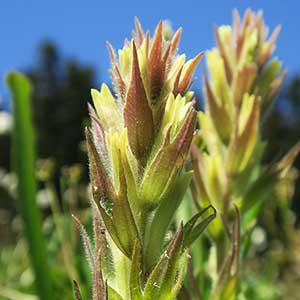Castilleja cryptantha
Castilleja lanata
Mt. Rainier or obscure paintbrush, obscure Indian paintbrush, obscure paintbrush
Sierra woolly Indian paintbrush, Sierra woolly paintbrush, woolly paintbrush
few to several, erect or ascending, unbranched, hairs spreading, long, soft, eglandular, mixed with short stipitate-glandular ones.
few to many, erect to ascending, unbranched, sometimes branched distally, sometimes with leafy axillary shoots, lanate to woolly, hairs dense, spreading to weakly appressed, white to yellowish, medium length, soft, moderately branched or unbranched in different populations, sometimes mixed, eglandular, rarely short stipitate-glandular, mostly obscuring surface.
green, often with brown or purple veins, narrowly to broadly lanceolate, 1.5–4 cm, not fleshy, margins plane, ± involute, 0–3-lobed, apex acute to acuminate;
lobes spreading-ascending, narrowly lanceolate, apex acute to ± obtuse.
green to purple, often hidden by matted, white hairs, linear to narrowly oblong or narrowly lanceolate, (1–)2–7(–10) cm, not fleshy, margins plane, flat, sometimes involute, 0–3-lobed, apex rounded, sometimes acute;
lobes spreading, linear or narrowly oblong, apex rounded to acute.
(2.5–)3–6 × 1–2 cm; green to dull brown or dull reddish purple throughout, or proximally green to dull brown or dull reddish purple, distally yellow on apices, broadly lanceolate to ovate, (0–)3-lobed;
lobes ascending, narrowly lanceolate, long or short, arising near mid length, apex acute or acuminate.
2–19 × 1.5–5 cm;
bracts proximally pale greenish to greenish gray, distally bright red to orange-red, sometimes pinkish, magenta, or salmon, rarely yellow, oblong to narrowly lanceolate or narrowly oblanceolate, deeply 0–3(–5)-lobed;
lobes spreading, oblanceolate or linear, long, arising below mid length, distal bract apex usually rounded.
straight, 14–16 mm;
tube 11–14 mm;
whole corolla included within calyx;
beak adaxially pale yellow, 1–2 mm;
abaxial lip deep green, slightly inflated, 4–5 mm, 67% as long as beak;
teeth ascending, pale, 1.5–2 mm.
curved in proximal 1/3, 23–35(–42) mm;
tube 12–17 mm;
beak exserted, adaxially greenish to yellowish, 11–22 mm;
abaxial lip dark green, reduced, 1–4 mm, ca. 20% as long as beak;
teeth incurved, reduced, green, 0.5–2.5 mm.
proximally green or pale with green veins, lobes yellow, sometimes becoming deep red with age, 12–15 mm;
abaxial and adaxial clefts 3–7 mm, 25–50% of calyx length, deeper than laterals, lateral 1–3(–4) mm, 8–20% of calyx length;
lobes triangular, adaxial segments longer than abaxials, apex acute or obtuse.
proximally whitish to green, central band whitish, distal 1/3 colored as bract lobes, sometimes lighter or deeper, 15–29 mm;
abaxial and adaxial clefts 6–14 mm, ca. 50% of calyx length, deeper than laterals, lateral 0–5 mm, 0–5(–15)% of calyx length;
lobes oblong to broadly triangular, apex rounded, truncate, or emarginate.
= 24.
= 24.
Castilleja cryptantha
Castilleja lanata
Castilleja cryptantha is endemic to the vicinity of Mt. Rainier in the Cascade Range, with most populations found within Mt. Rainier National Park. Unlike most species of Castilleja, it is apparently self-pollinating (W. J. Duffield 1972); the small flowers are entirely enclosed within the yellowish calyces, which tend to grow deep reddish as they age. The purplish brown bracts are also unusual in the genus.
(Discussion copyrighted by Flora of North America; reprinted with permission.)
Most records of Castilleja lanata are from the southern third of Arizona, New Mexico, and southwestern Texas. Plants sometimes referred to C. lanata from the Channel Islands of California are assigned here to C. hololeuca, an insular endemic. In northern Mexico, C. lanata extends from San Luis Potosí and Nuevo León westward to Sonora, with a disjunct distribution in central Baja California, where it overlaps the southern limits of a related species, C. foliolosa. Castilleja lanata inhabits a wide spectrum of soils and elevations and does not co-occur with the closely related C. galehintoniae in Nuevo León, where the latter is limited to limestone and gypsum substrates in a narrow elevational range. Hybrids of C. lanata with C. sessiliflora are known from Pecos County, Texas.
(Discussion copyrighted by Flora of North America; reprinted with permission.)


